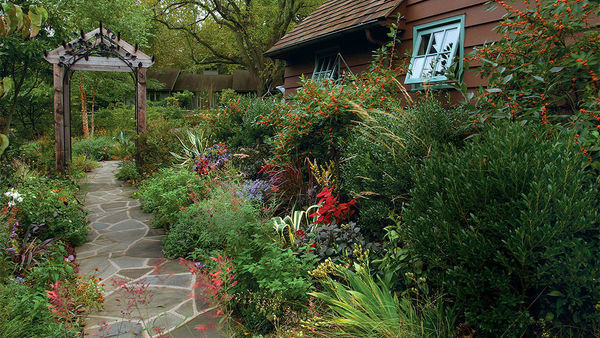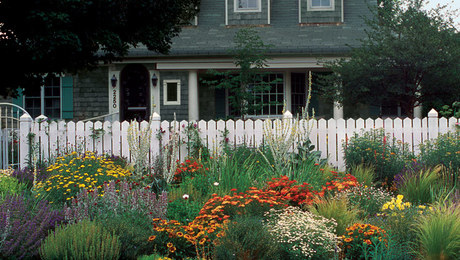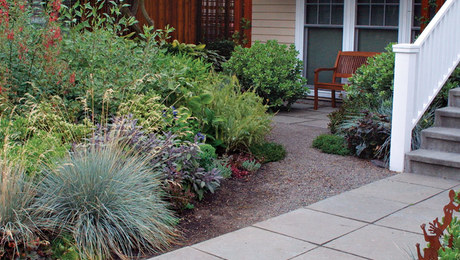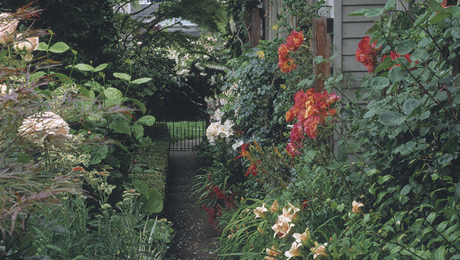
Many urban residential environments, despite their advantages, are cursed with an excess of asphalt, noise, and unsightly views. So for those of us who live in cities, there is much to be said for creating a private oasis, no matter how small the plot. Fortunately, I live on a street where the small yards are given mostly to lawn. Mine happened to be a weedy lawn, accented by little more than a few foundation shrubs, so the possibilities were endless for creating my own garden from scratch. Out front, I wanted to block the views of the cars, driveways, and power poles that line both sides of the street, and I wanted to create a sense of semi-privacy in the garden, while keeping the front door visible and accessible to visitors. Out back, I saw an opportunity for total privacy. To pull this off, I used a variety of enclosures—mostly green ones, accented or supported by a few structures—to mark the boundaries of my yard. By doing this, I’ve created a garden that is private on the inside and intriguing from the outside.
Tall plantings hide power lines

Photo/Illustration: Vincent Babak
To enclose the front garden, I started by planting large shrubs and trees at the property corners to screen the power lines from view. I did this with evergreen Burford and Foster’s hollies (Ilex cornuta ‘Burfordii’, USDA Hardiness Zones 7 to 9, and I. × attenuata ‘Foster #2’, Zones 6 to 9) and the deciduous Hydrangea paniculata ‘Tardiva’, Zones 3 to 8). I limbed up their multiple trunks to screen the power lines without completely blocking the view of the sidewalk. Also, the sculptural trunks are eye-catching.
From the street, these limbed-up trees and shrubs add a greater sense of depth as you look through them toward the house, making my tiny front yard seem just a little bigger. They also offer a backdrop for other plantings—annuals, perennials, and evergreen ground covers. Over time, as these anchor plants mature and create a shadier environment, I am replacing the sun-loving perennials and annuals with shade-loving perennials and ground covers.
Along one side in the front, I expanded this concept of mixed, layered plantings by establishing a screen of evergreen and deciduous plants from the corner of the lot to the house. Evergreen hollies and a chaste tree (Vitex agnus-castus, Zones 6 to 9) step down to Hydrangea macrophylla ‘Ayesha’ (Zones 6 to 9) and other flowering shrubs, annuals, and perennials to create a pocket garden anchored by a small birdbath.
A low hedge provides semi-privacy


Along the front edge of my shrinking lawn, I planted a low hedge of European beeches (Fagus sylvatica, Zones 5 to 7), though American beeches (F. grandifolia, Zones 3 to 9) would have easily maintained as a hedge if planted closely, pruned selectively in winter, and sheared a couple of times during the growing season.
I chose the beeches for several reasons. In addition to fitting the style of my cottage garden, they could be easily kept under 4 feet in height, which was important in the front yard, where I wanted something low enough to permit views both in and out of the garden. Also, I wanted something different from the traditional boxwood, holly, or privet hedge.

Though beeches are commonly grown in the South, you don’t often see them maintained as hedges. These beeches hold on to their leaves until early spring, when they put out delicate new growth that shimmers in the sunlight. In summer, the leaves are a rich green, and in the fall, they turn a beautiful golden color.
A vine-draped fence offers seasonal views
In winter, when the leaves have fallen from the neighborhood trees, I have a wonderful view of the Atlanta skyline. To preserve this view, I enclosed the south side of the front yard with open fencing draped in vines that drop their leaves once cold weather arrives.
The fence is constructed from three large black locust (Robinia pseudoacacia) posts with several steel rods driven through them horizontally. The black locust has a straight trunk and is slow to rot, making it ideal for fence posts and rails. Though it’s most commonly sold as split rails, I was able to obtain some unsplit logs.
The fence is draped with ‘Mermaid’ (Zones 6 to 9) and ‘New Dawn’ (Zones 5 to 9) roses and accented with several clematis vines, which make a fine spring show and provide plenty of dense, green foliage for screening throughout the summer. At their feet, on the public side, is a bed filled with colorful annuals and perennials.
Turn your sidewalk into a garden room


If you’re fortunate enough to have a sidewalk, you have the perfect spot for a garden area you can share with your neighbors. By planting both sides of my sidewalk with a mix of small trees, flowering shrubs, and perennials, I created a garden that rarely fails to slow down passersby. Since this is considered public space, it pays to keep a few things in mind when you plant this area.
- Choose trees that can mature comfortably in tight spaces. Persian ironwood (Parrotia persica, Zones 4 to 7), Kousa dogwood (Cornus kousa, Zones 5 to 8), and yaupon holly (Ilex vomitoria, Zones 8 to 10) have worked well for me.
- Keep in mind that as the trees mature, your once-sunny area will become shadier and you will probably have to change some of the underplantings.
- Include lots of bulbs for early spring color. Squill (Scilla spp. and cvs., Zones 5 to 8), daffodils (Narcissus spp. and cvs., Zones 3 to 9), and snowdrops (Galanthus spp. and cvs., Zones 3 to 9) are all good choices.
- Include flowering shrubs—both evergreen and deciduous—that either take well to pruning or won’t get too wide. Be keen on pruning, keeping in mind that scraggly branches can be an annoyance to those trying to park their cars.
- Add some self-sowing annuals such as spider flower (Cleome hassleriana), cockscomb (Celosia spp. and cvs.), or love-lies-bleeding (Amaranthus caudatus) for a splash of color throughout the summer.
- Keep in mind that the sidewalk strip tends to dry out more quickly than the rest of the garden. Be prepared to water, plant drought-tolerant species, or consider berming this area to create a slightly raised bed.
- Design several crossover areas so that people parking in front of your house can step out onto paving or stone instead of onto plants.
Plant both sides of a fence
For instant enclosure around a garden space, fencing is a clear alternative to hedges. In the backyard, where I could have used tall, solid plank fencing for privacy, I opted instead for hog-wire fencing strung between locust posts, to keep the dogs in check. Hog-wire fencing is exactly what you’d expect—rolls of wire fencing (with larger squares than those of hardware cloth or chicken wire) used by farmers to keep in hogs. And though I don’t think it makes a bad-looking fence, I planted both sides to create a lush, living wall that I find more interesting than almost any kind of fence because of the varied textures and the way it changes throughout the seasons.
That said, I recently added a small section of bamboo fencing along the back property line that I like specifically for its texture and the way it adds to the Asian theme I’ve been developing in my rear garden. I stumbled across this bamboo in an import shop, where it had been used as packing material.
Plantings can beautify a fence as well as soften its hard lines. In tight situations, all you need is a few inches of planting area to grow vines that can be trained along a fence. Though there’s limited space between the backyard fence and a driveway shared with neighbors, I’ve worked in a mix of narrow, upright shrubs, perennials, and shade-tolerant vines like five-leaf akebia (Akebia quinata, Zones 5 to 9). Inside the fence, where there’s a bit more room, I’m growing more Foster’s hollies along with a variety of other favorite plants.
The rear gate, which leads from the driveway to the backyard garden, is Asian inspired. The doors were rescued from a junk pile, and the rest of the structure, including the tin roof, was built to accommodate them. Unlike the open gate and arbor out front, this solid gate sends the message that this is my private retreat in the heart of the city.


















Comments
Log in or create an account to post a comment.
Sign up Log in